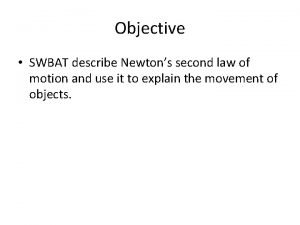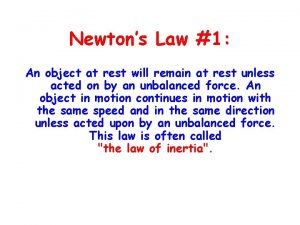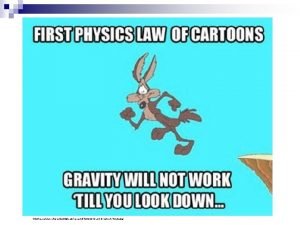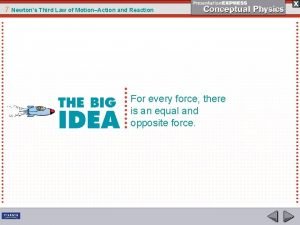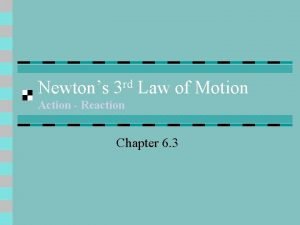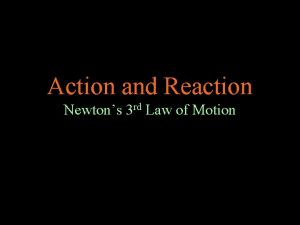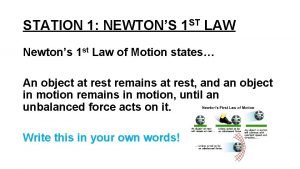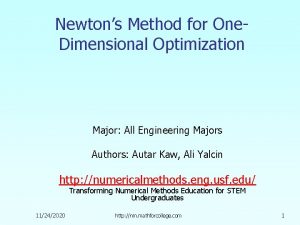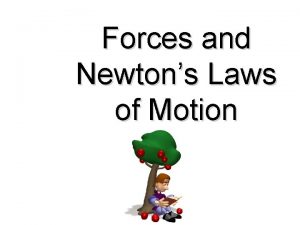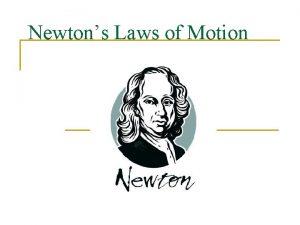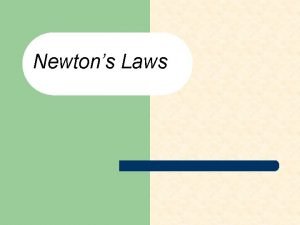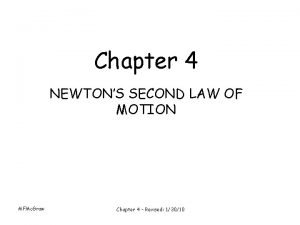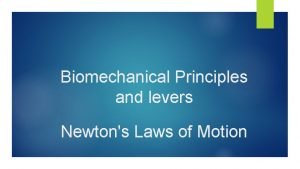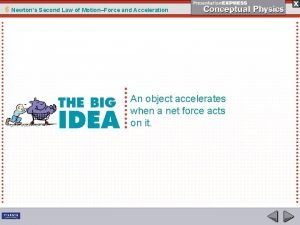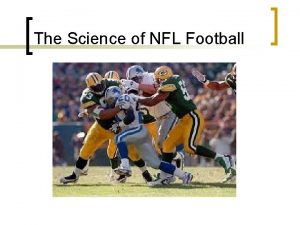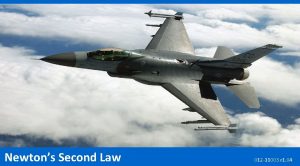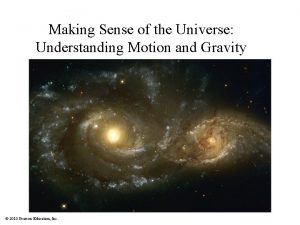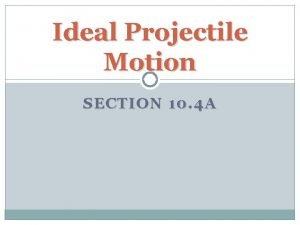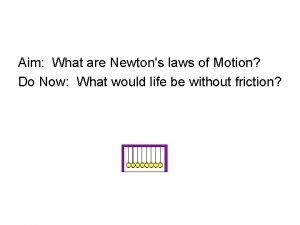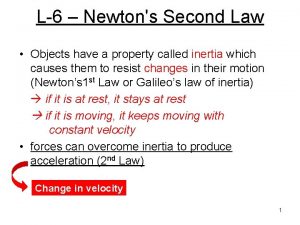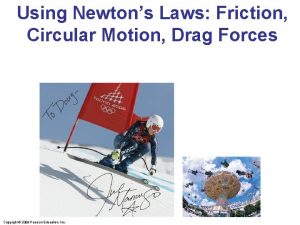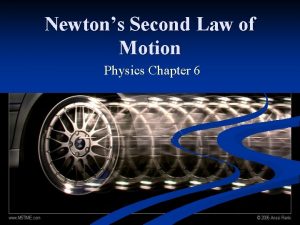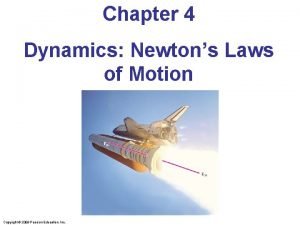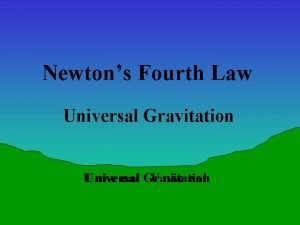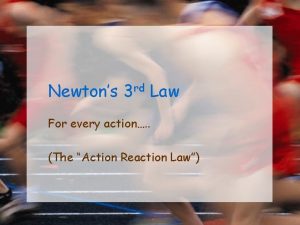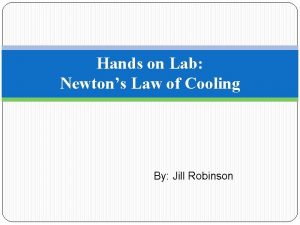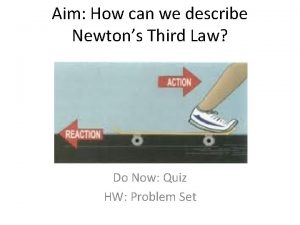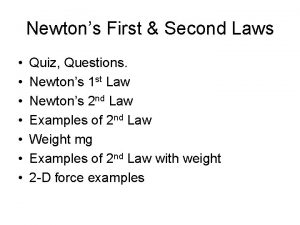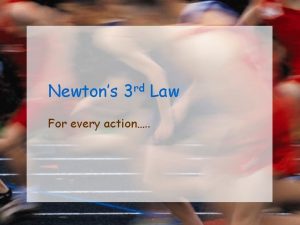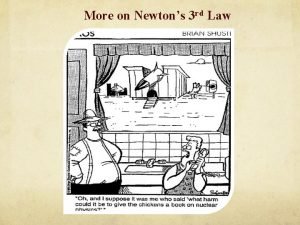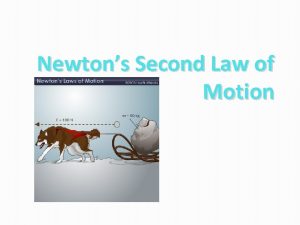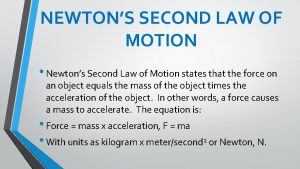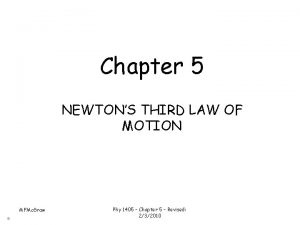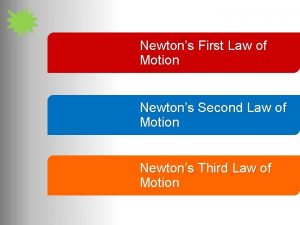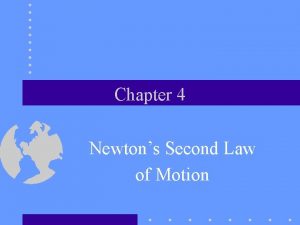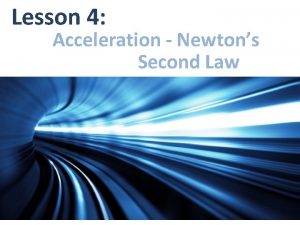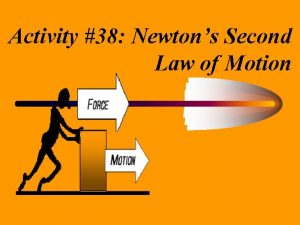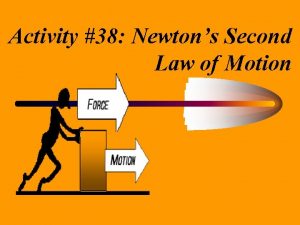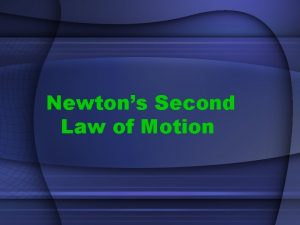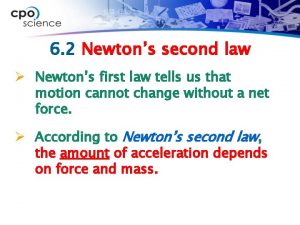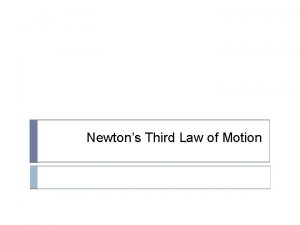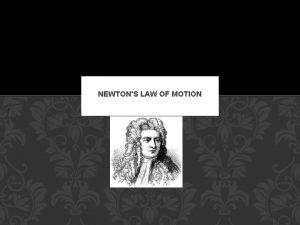Chapter 4 NEWTONS SECOND LAW OF MOTION MFMc



























































- Slides: 59

Chapter 4 NEWTON’S SECOND LAW OF MOTION MFMc. Graw Chapter 4 - Revised: 1/30/10

This lecture will help you understand: • • MFMc. Graw Force Causes Acceleration Friction Mass and Weight Mass Resists Acceleration Newton’s Second Law of Motion Free Fall Non-Free Fall Chapter 4 - Revised: 1/30/10

Force causes Acceleration • Acceleration depends on the net force. • Acceleration is directly proportional to net force. • To increase the acceleration of an object, you must increase the net force acting on it. Acceleration ~ net force MFMc. Graw Chapter 4 - Revised: 1/30/10

The Force of Friction • • depends on the kinds of material and how much they are pressed together. is due to tiny surface bumps and to “stickiness” of the atoms on a material’s surface. Example: Friction between a crate on a smooth wooden floor is less than that on a rough floor. MFMc. Graw Chapter 4 - Revised: 1/30/10

The Force of Friction CHECK YOUR NEIGHBOR When Sanjay pushes a refrigerator across a kitchen floor at a constant speed, the force of friction between the refrigerator and the floor is A. B. C. D. less than Sanjay’s push. equal to Sanjay’s push. equal and opposite to Sanjay’s push. more than Sanjay’s push. MFMc. Graw Chapter 4 - Revised: 1/30/10

The Force of Friction CHECK YOUR ANSWER When Sanjay pushes a refrigerator across a kitchen floor at a constant speed, the force of friction between the refrigerator and the floor is A. B. C. D. less than Sanjay’s push. equal to Sanjay’s push. equal and opposite to Sanjay’s push. more than Sanjay’s push. MFMc. Graw Chapter 4 - Revised: 1/30/10

The Force of Friction CHECK YOUR NEIGHBOR When Sanjay pushes a refrigerator across a kitchen floor at an increasing speed, the amount of friction between the refrigerator and the floor is A. B. C. D. less than Sanjay’s push. equal to Sanjay’s push. equal and opposite to Sanjay’s push. more than Sanjay’s push. MFMc. Graw Chapter 4 - Revised: 1/30/10

The Force of Friction CHECK YOUR ANSWER When Sanjay pushes a refrigerator across a kitchen floor at an increasing speed, the amount of friction between the refrigerator and the floor is A. B. C. D. less than Sanjay’s push. equal to Sanjay’s push. equal and opposite to Sanjay’s push. more than Sanjay’s push. Explanation: The increasing speed indicates a net force greater than zero. The refrigerator is not in equilibrium. MFMc. Graw Chapter 4 - Revised: 1/30/10

Mass and Weight • Mass: The quantity of matter in an object. It is also the measure of the inertia or sluggishness that an object exhibits in response to any effort made to start it, stop it, or change its state of motion in any way. • Weight: The force upon an object due to gravity. MFMc. Graw Chapter 4 - Revised: 1/30/10

Mass and Weight Mass • A measure of the inertia of a material object • Independent of gravity Greater inertia greater mass • Unit of measurement is the kilogram (kg) Weight • The force on an object due to gravity • Scientific unit of force is the newton (N) • Unit is also the pound (lb) MFMc. Graw Chapter 4 - Revised: 1/30/10

Mass—A Measure of Inertia CHECK YOUR NEIGHBOR If the mass of an object is halved, the weight of the object is A. B. C. D. halved. twice. depends on location. None of the above. MFMc. Graw Chapter 4 - Revised: 1/30/10

Mass—A Measure of Inertia CHECK YOUR ANSWER If the mass of an object is halved, the weight of the object is A. B. C. D. halved. twice. depends on location. None of the above. MFMc. Graw Chapter 4 - Revised: 1/30/10

Mass and Weight Mass and weight in everyday conversation are interchangeable. Mass, however, is different and more fundamental than weight. Mass versus weight • on the Moon and Earth: – Weight of an object on the Moon is less than on Earth. – Mass of an object is the same in both locations. MFMc. Graw Chapter 4 - Revised: 1/30/10

Mass and Weight Mass: The quantity of matter in an object. Also a measure of its inertia. Weight: The force exerted on an object due to gravity In the SI system of units – mass is in kilograms (kg) and weight is in Newtons (N) In using the metric system mass (kg) is used instead of newtons To convert back and forth between lbs and kg we are relating a “force” to a “mass” 1 kg = 2. 2046 lbs = 9. 8 N ~ 10 N (Approximately) 1 lb = 4. 45 N MFMc. Graw Chapter 4 - Revised: 1/30/10 14

Demo of Inertia & Weight Case A - Slow Pull the bottom string with gradually more force. Which string breaks? Case B - Fast Jerk the bottom string. Which string breaks? Which of these cases illustrates weight? Which of these cases illustrates inertia? MFMc. Graw Chapter 4 - Revised: 1/30/10 15

Demo of Inertia & Weight Case A - Slow The top string breaks when the bottom string is pulled with gradually more force. Case B - Fast The bottom string breaks when the bottom string is jerked. Which of these cases illustrates weight? Case A: Interestingly enough, it’s the weight of the ball that makes for the greater tension in the top string. Which of these cases illustrates inertia? Case B: When jerked, the tendency of the ball to resist the sudden downward acceleration, its inertia, is responsible for the lower string breaking. MFMc. Graw Chapter 4 - Revised: 1/30/10 16

Mass Resists Acceleration The same force applied to • Twice the mass produces half the acceleration. • 3 times the mass, produces 1/3 the acceleration. • Acceleration is inversely proportional to mass. MFMc. Graw Chapter 4 - Revised: 1/30/10

Newton’s Second Law of Motion Isaac Newton was the first to connect the concepts of force and mass to produce acceleration. MFMc. Graw Chapter 4 - Revised: 1/30/10

Newton’s Second Law of Motion Newton’s second law (the law of acceleration) relates acceleration to force. The acceleration produced by a net force on an object is directly proportional to the net force, is in the same direction as the net force, and is inversely proportional to the mass of the object. MFMc. Graw Chapter 4 - Revised: 1/30/10

Newton’s Second Law of Motion In equation form: net force Acceleration mass Example: If net force acting on object is doubled object’s acceleration will be doubled. If mass of object is doubled object’s acceleration will be halved. MFMc. Graw Chapter 4 - Revised: 1/30/10

Newton’s Second Law of Motion MFMc. Graw Chapter 4 - Revised: 1/30/10

Newton’s Second Law of Motion CHECK YOUR NEIGHBOR Consider a cart pushed along a track with a certain force. If the force remains the same while the mass of the cart decreases to half, the acceleration of the cart A. B. C. D. remains relatively the same. halves. doubles. changes unpredictably. MFMc. Graw Chapter 4 - Revised: 1/30/10

Newton’s Second Law of Motion CHECK YOUR ANSWER Consider a cart pushed along a track with a certain force. If the force remains the same while the mass of the cart decreases to half, the acceleration of the cart A. A. remains relatively the same. B. B. halves. C. C. doubles. D. D. changes unpredictably. Explanation: Acceleration = net force / mass Because, mass is in the denominator, acceleration increases as mass decreases. So, if mass is halved, acceleration doubles. MFMc. Graw Chapter 4 - Revised: 1/30/10

Newton’s Second Law of Motion CHECK YOUR NEIGHBOR Push a cart along a track so twice as much net force acts on it. If the acceleration remains the same, what is a reasonable explanation? A. B. C. D. The mass of the cart doubled when the force doubled. The cart experiences a force that it didn’t before. The track is not level. Friction reversed direction. MFMc. Graw Chapter 4 - Revised: 1/30/10

Newton’s Second Law of Motion CHECK YOUR ANSWER Push a cart along a track so twice as much net force acts on it. If the acceleration remains the same, what is a reasonable explanation? A. B. C. D. The mass of the cart doubled when the force doubled. The cart experiences a force that it didn’t before. The track is not level. Friction reversed direction. Explanation: Acceleration = net force / mass If force doubles, acceleration will also double, But it does not, so mass must also be doubling to cancel out effects of force doubling. MFMc. Graw Chapter 4 - Revised: 1/30/10

Newton’s Second Law of Motion “The acceleration of an object is directly proportional to the net force acting on the object, is in the direction of the net force, and is inversely proportional to the mass of the object. ” Net F = ma MFMc. Graw Chapter 4 - Revised: 1/30/10 26

Newton’s Second Law of Motion The maximum acceleration of a car while towing a second car twice its mass, compared to its acceleration with no car in tow, is MFMc. Graw Chapter 4 - Revised: 1/30/10 27

Newton’s Second Law In Case 1. a second 10 kg mass provides the 100 N force but its mass becomes part of the system and must be accelerated along with the original 10 kg mass. In Case 2. the source providing the force adds no mass to the system. MFMc. Graw Chapter 4 - Revised: 1/30/10 28

Newton’s Second Law Answer: 2 The one-block system has the greater acceleration. This is because different accelerations are produced when the same force is applied to systems of different mass. Twice the mass is being accelerated in the two-block system, so its acceleration is half that of the one-block system. MFMc. Graw Chapter 4 - Revised: 1/30/10 (Can you see that since the applied force equals the weight of the oneblock system, it accelerates at g? And that the two-block system accelerates at g/2? And can you see that the rope tensions in the two cases are unequal? That it must be 50 N for the two-block system? ) 29

Free Fall The greater the mass of the object… • the greater its force of attraction toward the Earth. • the smaller its tendency to move i. e. , the greater its inertia. So, the acceleration is the same. It is equal to the acceleration due to gravity: 10 m/s 2 (precisely 9. 8 m/s 2). MFMc. Graw Chapter 4 - Revised: 1/30/10

Free Fall When acceleration is g—free fall • Newton’s second law provides an explanation for the equal accelerations of freely falling objects of various masses. • Acceleration is equal when air resistance is negligible. • Acceleration depends on force (weight) and inertia. MFMc. Graw Chapter 4 - Revised: 1/30/10

Free Fall CHECK YOUR NEIGHBOR At one instant, an object in free fall has a speed of 40 m/s. Its speed 1 second later is A. B. C. D. also 40 m/s. 45 m/s. 50 m/s. None of the above. MFMc. Graw Chapter 4 - Revised: 1/30/10

Free Fall CHECK YOUR ANSWER At one instant, an object in free-fall has a speed of 40 m/s. Its speed 1 second later is A. B. C. D. also 40 m/s. 45 m/s. 50 m/s. None of the above. Comment: We assume the object is falling downward. MFMc. Graw Chapter 4 - Revised: 1/30/10

Free Fall CHECK YOUR NEIGHBOR A 5 -kg iron ball and a 10 -kg iron ball are dropped from rest. For negligible air resistance, the acceleration of the heavier ball will be A. B. C. D. less. the same. more. undetermined. MFMc. Graw Chapter 4 - Revised: 1/30/10

Free Fall CHECK YOUR ANSWER A 5 -kg iron ball and a 10 -kg iron ball are dropped from rest. For negligible air resistance, the acceleration of the heavier ball will be A. B. C. D. less. the same. more. undetermined. MFMc. Graw Chapter 4 - Revised: 1/30/10

Free Fall CHECK YOUR NEIGHBOR A 5 -kg iron ball and a 10 -kg iron ball are dropped from rest. When the free-falling 5 -kg ball reaches a speed of 10 m/s, the speed of the free-falling 10 -kg ball is A. B. C. D. less than 10 m/s. more than 10 m/s. undetermined. MFMc. Graw Chapter 4 - Revised: 1/30/10

Free Fall CHECK YOUR ANSWER A 5 -kg iron ball and a 10 -kg iron ball are dropped from rest. When the free-falling 5 -kg ball reaches a speed of 10 m/s, the speed of the free-falling 10 -kg ball is A. B. C. D. less than 10 m/s. more than 10 m/s. undetermined. MFMc. Graw Chapter 4 - Revised: 1/30/10

Non-Free Fall When an object falls downward through the air it experiences • force of gravity pulling it downward. • air drag force acting upward. MFMc. Graw Chapter 4 - Revised: 1/30/10

Non-Free Fall When acceleration of fall is less than g, non-free fall • occurs when air resistance is nonnegligible. • depends on two things: • speed and • frontal surface area. MFMc. Graw Chapter 4 - Revised: 1/30/10

Nonfree Fall Wind resistance – Source: Impact with air molecules Area dependence Velocity dependence Start with a hand out a car window: • in the parking lot; • on the street and finally • on the expressway. Examine wind resistance on a single ball that is falling. Cross sectional area – more instantaneous collisions Velocity (speed) – more collisions per second Terminal velocity wind resistance = weight What if the ball were larger in diameter? MFMc. Graw Chapter 4 - Revised: 1/30/10 40

Non-Free Fall • When the object is moving fast enough that force of gravity equals its air resistance • Then no net force No acceleration Velocity does not change MFMc. Graw Chapter 4 - Revised: 1/30/10

Non-Free Fall Terminal speed • occurs when acceleration terminates (when air resistance equals weight and net force is zero). Terminal velocity • same as terminal speed, with direction implied or specified. MFMc. Graw Chapter 4 - Revised: 1/30/10

Non-Free Fall—Example • A skydiver jumps from plane. • Weight is the only force until air resistance acts. • As falling speed increases, air resistance on diver builds up, net force is reduced, and acceleration becomes less. • When air resistance equals the diver’s weight, net force is zero and acceleration terminates. • Diver reaches terminal velocity, then continues the fall at constant speed. MFMc. Graw Chapter 4 - Revised: 1/30/10

Non-Free Fall CHECK YOUR NEIGHBOR When a 20 -N falling object encounters 5 N of air resistance, its acceleration of fall is A. B. C. D. less than g. more than g. g. terminated. MFMc. Graw Chapter 4 - Revised: 1/30/10

Non-Free Fall CHECK YOUR ANSWER When a 20 -N falling object encounters 5 N of air resistance, its acceleration of fall is A. B. C. D. less than g. more than g. g. terminated. Comment: Acceleration of a non-free fall is always less than g. Acceleration will actually be (20 N – 5 N)/2 kg = 7. 5 m/s 2. MFMc. Graw Chapter 4 - Revised: 1/30/10

Non-Free Fall CHECK YOUR NEIGHBOR If a 50 -N person is to fall at terminal speed, the air resistance needed is A. B. C. D. less than 50 N. more than 50 N. None of the above. MFMc. Graw Chapter 4 - Revised: 1/30/10

Non-Free Fall CHECK YOUR ANSWER If a 50 -N person is to fall at terminal speed, the air resistance needed is A. B. C. D. less than 50 N. more than 50 N. None of the above. Explanation: Then, F = 0 and acceleration = 0. MFMc. Graw Chapter 4 - Revised: 1/30/10

Non-Free Fall CHECK YOUR NEIGHBOR As the skydiver falls faster and faster through the air, air resistance A. B. C. D. increases. decreases. remains the same. Not enough information. MFMc. Graw Chapter 4 - Revised: 1/30/10

Non-Free Fall CHECK YOUR ANSWER As the skydiver falls faster and faster through the air, air resistance A. B. C. D. increases. decreases. remains the same. Not enough information. MFMc. Graw Chapter 4 - Revised: 1/30/10

Non-Free Fall CHECK YOUR NEIGHBOR As the skydiver continues to fall faster and faster through the air, net force A. B. C. D. increases. decreases. remains the same. Not enough information. MFMc. Graw Chapter 4 - Revised: 1/30/10

Non-Free Fall CHECK YOUR ANSWER As the skydiver continues to fall faster and faster through the air, net force A. B. C. D. increases. decreases. remains the same. Not enough information. MFMc. Graw Chapter 4 - Revised: 1/30/10

Non-Free Fall CHECK YOUR NEIGHBOR As the skydiver continues to fall faster and faster through the air, her acceleration A. B. C. D. increases. decreases. remains the same. Not enough information. MFMc. Graw Chapter 4 - Revised: 1/30/10

Non-Free Fall CHECK YOUR ANSWER As the skydiver continues to fall faster and faster through the air, her acceleration A. B. C. D. increases. decreases. remains the same. Not enough information. Comment If this question were asked first in the sequence of skydiver questions, many would answer it incorrectly. Would this have been you? MFMc. Graw Chapter 4 - Revised: 1/30/10

Non-Free Fall CHECK YOUR NEIGHBOR Consider a heavy and light person jumping together with same-size parachutes from the same altitude. Who will reach the ground first? A. B. C. D. The light person. The heavy person. Both will reach at the same time. Not enough information. MFMc. Graw Chapter 4 - Revised: 1/30/10

Non-Free Fall CHECK YOUR ANSWER Consider a heavy and light person jumping together with same-size parachutes from the same altitude. Who will reach the ground first? A. B. C. D. The light person The heavy person Both will reach at the same time. Not enough information. Explanation: • They both have the same drag force (for the same speed). • The man (heavier) has a greater downward force than the woman (lighter). • The man has to drop farther to receive drag force equal to his downward force, so a higher terminal velocity. MFMc. Graw Chapter 4 - Revised: 1/30/10

Free Fall vs. Non-Free Fall Coin and feather fall with air present • Feather reaches terminal velocity very quickly and falls slowly at constant speed, reaching the bottom after the coin does. • Coin falls very quickly and air resistance doesn’t build up to its weight over short-falling distances, which is why the coin hits the bottom much sooner than the falling feather. MFMc. Graw Chapter 4 - Revised: 1/30/10

Non-Free Fall CHECK YOUR NEIGHBOR When the air is removed by a vacuum pump and the coin and feather activity is repeated, A. B. C. D. the feather hits the bottom first, before the coin hits the bottom first, before the feather hits. both the coin and feather drop together side-byside. Not enough information. MFMc. Graw Chapter 4 - Revised: 1/30/10

Non-Free Fall CHECK YOUR ANSWER When the air is removed by a vacuum pump and the coin and feather activity is repeated, A. B. C. D. the feather hits the bottom first, before the coin hits the bottom first, before the feather hits. both the coin and feather drop together side-by-side. Not enough information. MFMc. Graw Chapter 4 - Revised: 1/30/10

Free Fall vs. Non-Free Fall Coin and feather fall in vacuum • There is no air, because it is vacuum. • So, no air resistance. • Coin and feather fall together. MFMc. Graw Chapter 4 - Revised: 1/30/10
 Second law of motion
Second law of motion Newton's second law of motion
Newton's second law of motion Newton's first law of motion in soccer
Newton's first law of motion in soccer Describe newtons second law
Describe newtons second law Newtons second law
Newtons second law Newtons second law example
Newtons second law example Newtons 3 rd law of motion
Newtons 3 rd law of motion Newtons 3 rd law of motion
Newtons 3 rd law of motion Newton’s 3rd law
Newton’s 3rd law Rd law
Rd law Newton's first law of motion meme
Newton's first law of motion meme Newtons third law of motion
Newtons third law of motion Newtons third law of motion
Newtons third law of motion Newtons 3 rd law of motion
Newtons 3 rd law of motion Newton's 3 laws
Newton's 3 laws Newtons 3 rd law of motion
Newtons 3 rd law of motion What is newtons first law
What is newtons first law Brainpop newton's laws of motion worksheet answer key
Brainpop newton's laws of motion worksheet answer key Newton's first law and second law and third law
Newton's first law and second law and third law Newton's first law of motion
Newton's first law of motion Newtons second kaw
Newtons second kaw Newtons second kaw
Newtons second kaw Newtons second laq
Newtons second laq 3 newton's laws
3 newton's laws Newton's laws
Newton's laws Newtons first aw
Newtons first aw Second law of motion
Second law of motion When the pellet fired into the spiral tube
When the pellet fired into the spiral tube Newton's second law of motion
Newton's second law of motion Newton's second law of motion free fall
Newton's second law of motion free fall Newton's laws of motion biomechanics
Newton's laws of motion biomechanics Law of force and acceleration
Law of force and acceleration Newton's second law of motion - science of nfl football
Newton's second law of motion - science of nfl football Newton's second law of motion in soccer
Newton's second law of motion in soccer Newton's second law of motion
Newton's second law of motion Kepler's second law of motion
Kepler's second law of motion Ideal projectile motion
Ideal projectile motion Unbalanced force
Unbalanced force Second law of motion
Second law of motion 2nd law of motion
2nd law of motion Fluid momentum
Fluid momentum Newtons laws
Newtons laws Physics
Physics Newton's second law of motion states that quizlet
Newton's second law of motion states that quizlet Newton's second law of motion
Newton's second law of motion Colin skateboards down the sidewalk
Colin skateboards down the sidewalk The 3 law of motion
The 3 law of motion Newtons 3
Newtons 3 When dishes remain on a table when you yank
When dishes remain on a table when you yank Newtons fourth law
Newtons fourth law Newton's 3 law
Newton's 3 law Newtons 3 rd law
Newtons 3 rd law Site:slidetodoc.com
Site:slidetodoc.com Describe newtons third law
Describe newtons third law Newtons third law of thermodynamics
Newtons third law of thermodynamics Newtons st law
Newtons st law Newton's first and second law quiz
Newton's first and second law quiz Newtons 3 rd law
Newtons 3 rd law What is reaction force
What is reaction force Newtons 3 rd law
Newtons 3 rd law



